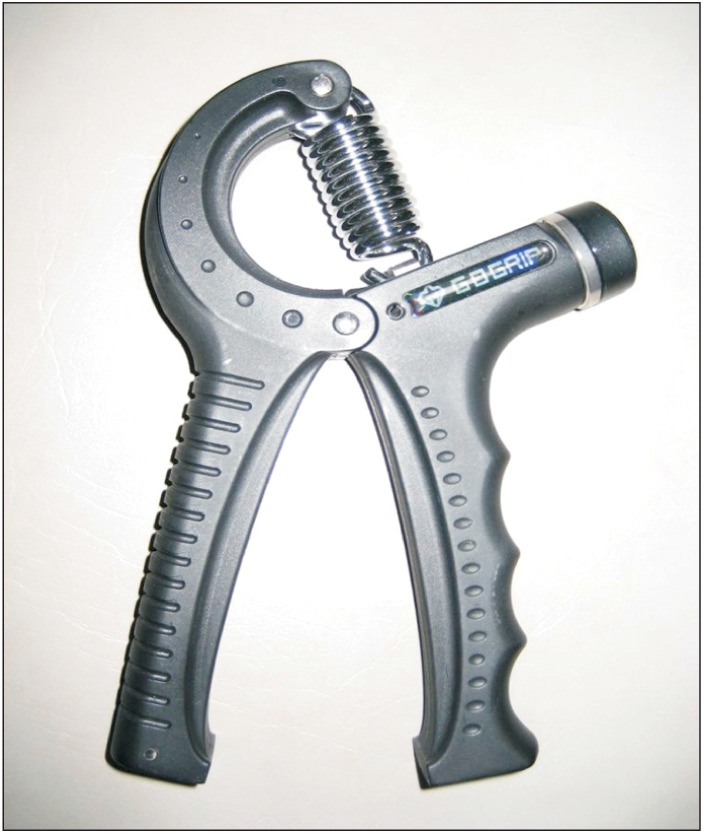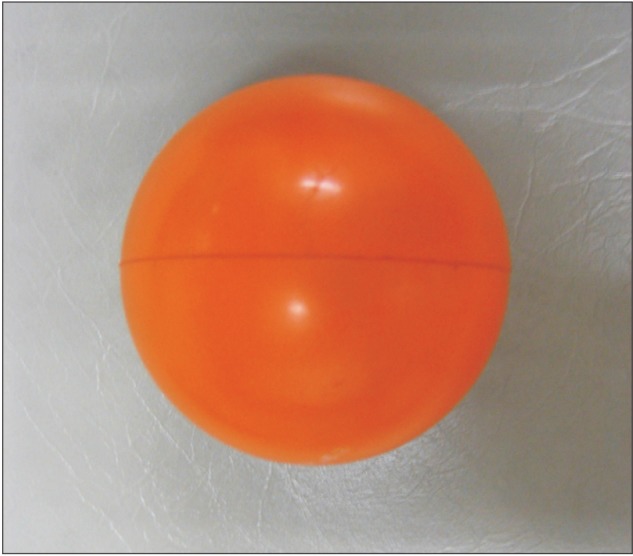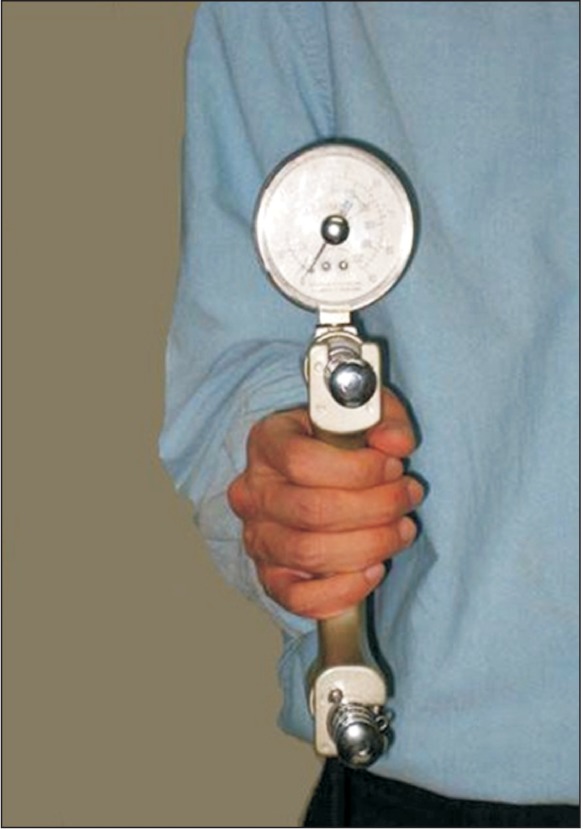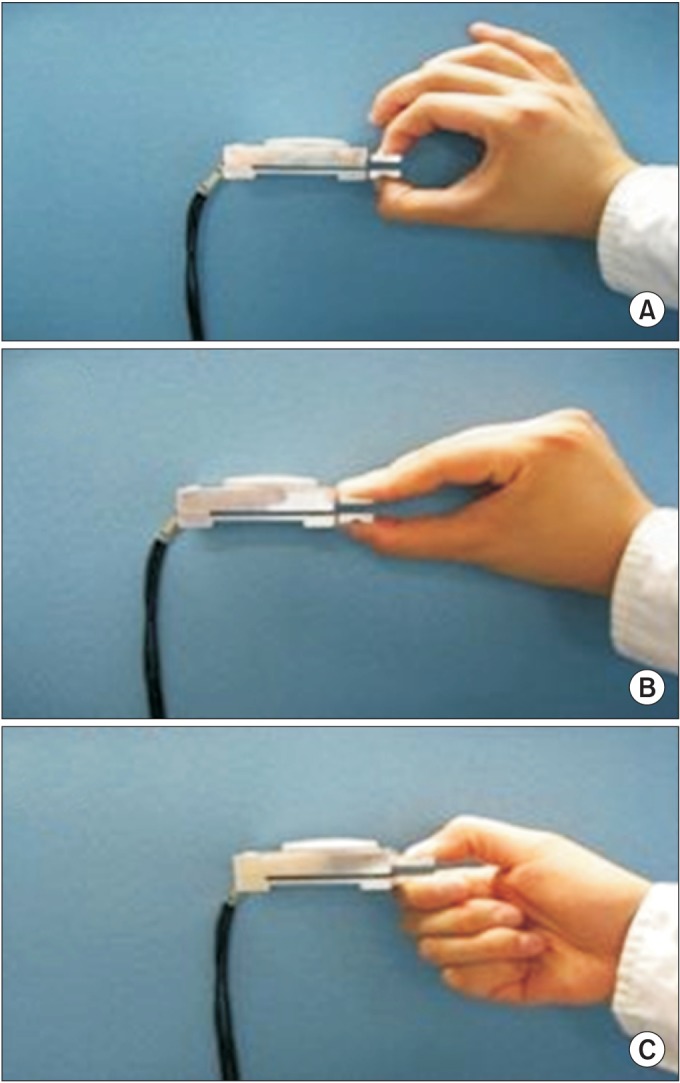Ann Rehabil Med.
2014 Oct;38(5):648-657. 10.5535/arm.2014.38.5.648.
The Effect of Two Different Hand Exercises on Grip Strength, Forearm Circumference, and Vascular Maturation in Patients Who Underwent Arteriovenous Fistula Surgery
- Affiliations
-
- 1Department of Rehabilitation Medicine, Hanyang University College of Medicine, Seoul, Korea.
- 2Department of Rehabilitation Medicine, Hanyang University Guri Hospital, Hanyang University College of Medicine, Guri, Korea. systole77@hanmail.net
- KMID: 2266499
- DOI: http://doi.org/10.5535/arm.2014.38.5.648
Abstract
OBJECTIVE
To compare the effect of two different hand exercises on hand strength and vascular maturation in patients who underwent arteriovenous fistula surgery.
METHODS
We recruited 18 patients who had chronic kidney disease and had undergone arteriovenous fistula surgery for hemodialysis. After the surgery, 10 subjects performed hand-squeezing exercise with GD Grip, and other 8 subjects used Soft Ball. The subjects continued the exercises for 4 weeks. The hand grip strength, pinch strength (tip, palmar and lateral pinch), and forearm circumference of the subjects were assessed before and after the hand-squeezing exercise. The cephalic vein size, blood flow velocity and volume were also measured by ultrasonography in the operated limb.
RESULTS
All of the 3 types of pinch strengths, grip strength, and forearm circumference were significantly increased in the group using GD Grip. Cephalic vein size and blood flow volume were also significantly increased. However, blood flow velocity showed no difference after the exercise. The group using Soft Ball showed a significant increase in the tip and lateral pinch strength and forearm circumference. The cephalic vein size and blood flow volume were also significantly increased. On comparing the effect of the two different hand exercises, hand-squeezing exercise with GD Grip had a significantly better effect on the tip and palmar pinch strength than hand-squeezing exercise with Soft Ball. The effect on cephalic vein size was not significantly different between the two groups.
CONCLUSION
The results showed that hand squeezing exercise with GD Grip was more effective in increasing the tip and palmar pinch strength compared to hand squeezing exercise with soft ball.
MeSH Terms
Figure
Reference
-
1. Kim EJ, Hwang SH, Lim SP, Lee Y. Early results of AV fistula creation for CRF patients. Chungnam Med J. 1991; 18:451–455.2. Park KY, Kim GH, Kim HJ, Chae DW, Noh JW, Koo JR, et al. The influence of maturation period of arteriovenous fistula on its survival in patients undergoing maintenance hemodialysis. Korean J Med. 1999; 57:66–74.3. Hakim R, Himmelfarb J. Hemodialysis access failure: a call to action. Kidney Int. 1998; 54:1029–1040. PMID: 9767519.
Article4. Brescia MJ, Cimino J, Appel K, Hurwich B. Chronic hemodialysis using venipuncture and a surgically created arteriovenous fistula. N Engl J Med. 1966; 275:1089–1092. PMID: 5923023.
Article5. Rus R, Ponikvar R, Kenda R, Buturovic-Ponikvar J. Effects of handgrip training and intermittent compression of upper arm veins on forearm vessels in patients with end-stage renal failure. Ther Apher Dial. 2005; 9:241–244. PMID: 15966998.
Article6. Jendrisak MD, Anderson CB. Vascular access in patients with arterial insufficiency. Construction of proximal bridge fistulae based on inflow from axillary branch arteries. Ann Surg. 1990; 212:187–193. PMID: 2375649.7. Bicknell JM, Lim AC, Raroque HG Jr, Tzamaloukas AH. Carpal tunnel syndrome, subclinical median mononeuropathy, and peripheral polyneuropathy: common early complications of chronic peritoneal dialysis and hemodialysis. Arch Phys Med Rehabil. 1991; 72:378–381. PMID: 1647756.8. Culp K, Flanigan M, Taylor L, Rothstein M. Vascular access thrombosis in new hemodialysis patients. Am J Kidney Dis. 1995; 26:341–346. PMID: 7645539.
Article9. Oder TF, Teodorescu V, Uribarri J. Effect of exercise on the diameter of arteriovenous fistulae in hemodialysis patients. ASAIO J. 2003; 49:554–555. PMID: 14524563.
Article10. Vascular Access 2006 Work Group. Clinical practice guidelines for vascular access. Am J Kidney Dis. 2006; 48(Suppl 1):S176–S247. PMID: 16813989.11. Leaf DA, MacRae HS, Grant E, Kraut J. Isometric exercise increases the size of forearm veins in patients with chronic renal failure. Am J Med Sci. 2003; 325:115–119. PMID: 12640286.
Article12. Wendelhag I, Fagerberg B, Wikstrand J. Adding ischaemic hand exercise during occlusion of the brachial artery increases the flow-mediated vasodilation in ultrasound studies of endothelial function. Clin Physiol. 1999; 19:279–283. PMID: 10451786.
Article13. Rus RR, Ponikvar R, Kenda RB, Buturovic-Ponikvar J. Effect of local physical training on the forearm arteries and veins in patients with end-stage renal disease. Blood purif. 2003; 21:389–394. PMID: 14586181.
Article14. Petersen P, Petrick M, Connor H, Conklin D. Grip strength and hand dominance: challenging the 10% rule. Am J Occup Ther. 1989; 43:444–447. PMID: 2750859.
Article15. Gilbert JC, Knowlton RG. Simple method to determine sincerity of effort during a maximal isometric test of grip strength. Am J Phys Med. 1983; 62:135–144. PMID: 6859248.16. Ranganathan VK, Siemionow V, Sahgal V, Liu JZ, Yue GH. Skilled finger movement exercise improves hand function. J Gerontol A Biol Sci Med Sci. 2001; 56:M518–M522. PMID: 11487606.
Article17. Bechtol CO. Grip test the use of a dynamometer with adjustable handle spacings. J Bone Joint Surg Am. 1954; 36-A:820–824. PMID: 13174611.18. Mathiowetz V, Weber K, Volland G, Kashman N. Reliability and validity of grip and pinch strength evaluations. J Hand Surg Am. 1984; 9:222–226. PMID: 6715829.
Article19. Lee SJ, Park JW, Park BJ, Han SH, Yoo DH, Kim MJ. The comparison of hand grip and pinch strength between rheumatoid arthritis and control groups. J Korean Acad Rehabil Med. 2008; 32:200–205.20. Park HS, Lee KM, Kim SY. Grip and pinch strength evaluation in patients with rheumatoid arthritis. J Korean Acad Rehabil Med. 1989; 13:170–176.21. Kim YT, Kang SY, Kim HS, Shin BS. Hand strength and dexterity evaluation with age. J Korean Acad Rehabil Med. 1994; 18:780–788.22. Moon MS, Ok IY, Kim HJ. The study of pinching type and power. J Korean Orthop Assoc. 1982; 17:206–212.23. Lee SJ, Kim SH, Kim HT, Kim MJ. The comparison of hand grip and pinch strength between Parkinson's disease and control group. Korean J Clin Geriatr. 2006; 7:433–439.24. Fleckenstein JL, Watumull D, Bertocci LA, Parkey RW, Peshock RM. Finger-specific flexor recruitment in humans: depiction by exercise-enhanced MRI. J Appl Physiol (1985). 1992; 72:1974–1977. PMID: 1601807.
Article25. Choi C, Kwon S, Park W, Lee HD, Kim J. Real-time pinch force estimation by surface electromyography using an artificial neural network. Med Eng Phys. 2010; 32:429–436. PMID: 20430679.
Article26. MacKenzie C, Iberall T. The grasping hand. 1st ed. Amsterdam: Elsevier Science;1994.27. Towles JD, Hentz VR, Murray WM. Use of intrinsic thumb muscles may help to improve lateral pinch function restored by tendon transfer. Clin Biomech (Bristol, Avon). 2008; 23:387–394.
Article28. Keen DA, Yue GH, Enoka RM. Training-related enhancement in the control of motor output in elderly humans. J Appl Physiol (1985). 1994; 77:2648–2658. PMID: 7896604.
Article29. Baar K, Nader G, Bodine S. Resistance exercise, muscle loading/unloading and the control of muscle mass. Essays Biochem. 2006; 42:61–74. PMID: 17144880.
Article30. Zimmerman DW. Comparative power of Student t test and Mann-Whitney U test for unequal sample sizes and variances. J Exp Educ. 1987; 55:171–174.31. Mundry R, Fischer J. Use of statistical programs for nonparametric tests of small samples often leads to incorrect P values: examples from Animal Behaviour. Anim Behav. 1998; 56:256–259. PMID: 9710485.
- Full Text Links
- Actions
-
Cited
- CITED
-
- Close
- Share
- Similar articles
-
- Effect of forearm compression sleeve on muscle fatigue during robotic surgery: a randomized controlled study
- The relationship between grip strength and radius bone mineral density in postmenopausal women
- Clinical Experience of Proximal Radio-Cephalic Fistula
- Simulation of healthcare provider's safety on emergency transportation using advanced airway: extension tube usage or not
- Development of Predictive Model for Assessment of Grip Strength among Koreans: Data from 2014-2015 Korea National Health and Nutrition Examination Survey





